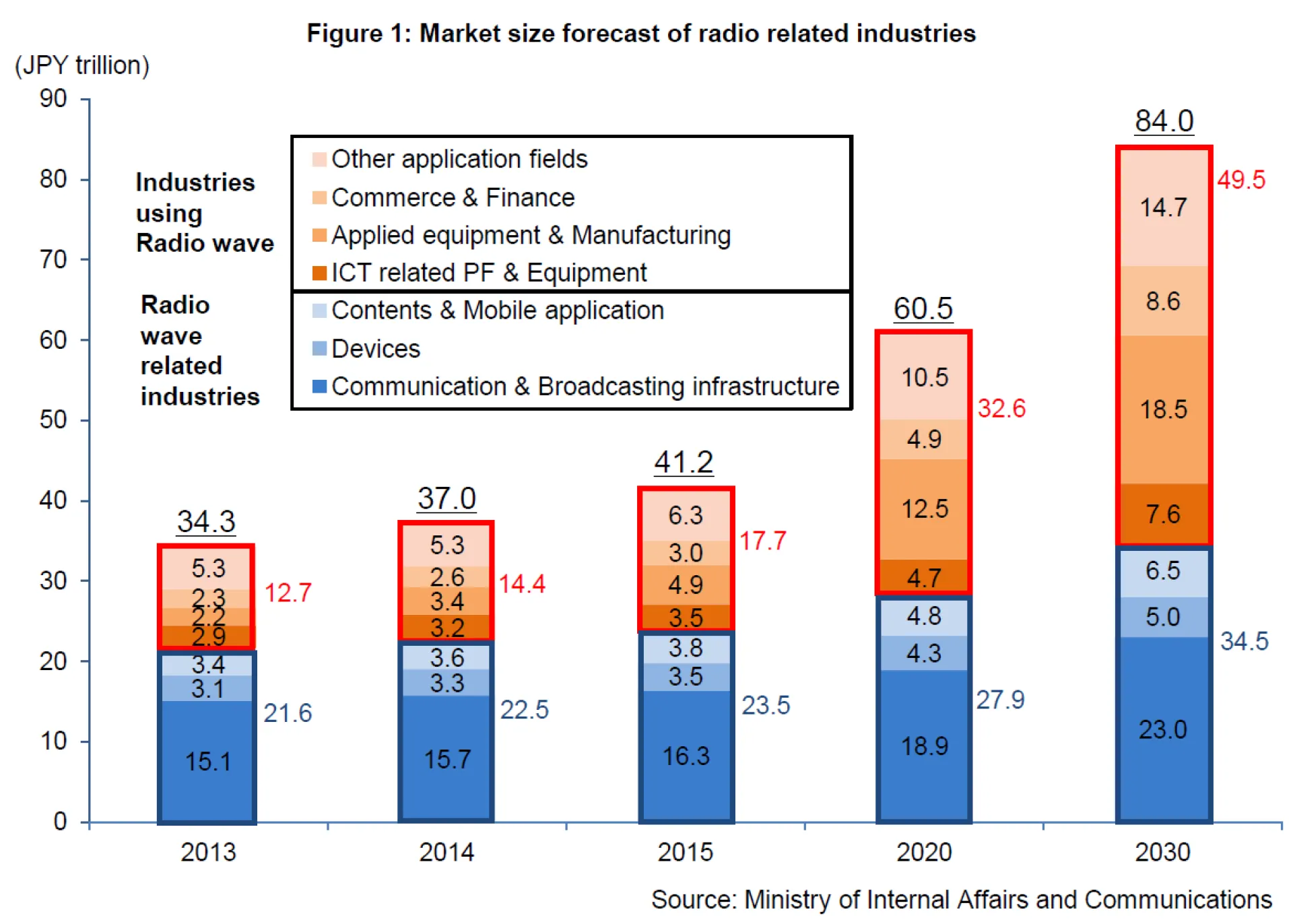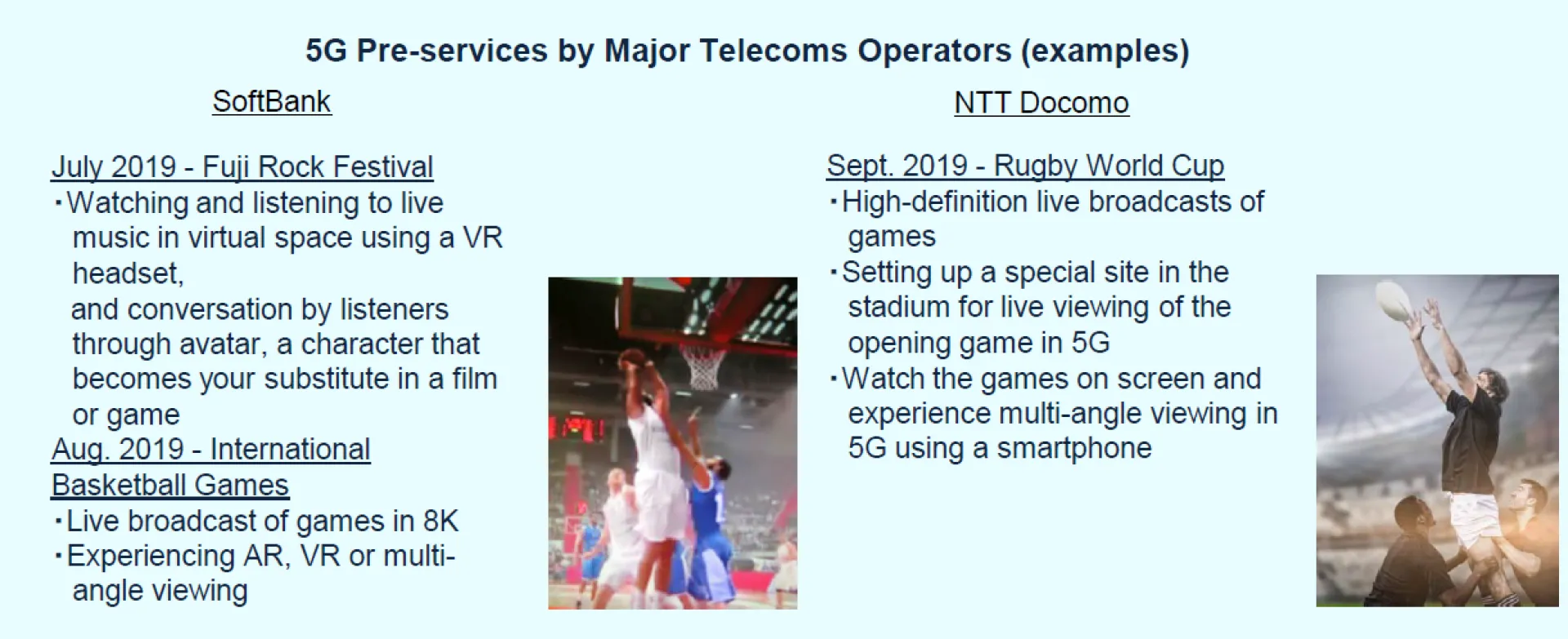
SoftBank began pre-servicing its 5G (Fifth Generation Cellular Network Technology) platform at the Fuji Rock Festival, Japan’s largest outdoor music event, in July 2019. It was the first time that a public audience at a music festival got to experience 5G and it received a lot of attention.
NTT Docomo began its pre-service of 5G in September 2019 to coincide with the Rugby World Cup. Although the company won’t begin offering 5G services to the public until the spring of 2020, pre-service participants are able to experience 5G technology firsthand using the same base station and frequency bands as the actual telecoms network. NTT Docomo calls this event the “true beginning of 5G”.
A New Audio-visual experience using 5G and xR
5G features high speed, large data capacity, low latency and multiple, simultaneous access. It is highly compatible with music and sports, and is an evolving technology that brings entertainment to a new level. The pre-service by SoftBank and NTT Docomo is an experience made available by making the most of 5G’s features while using xR which refers to3D technology such as AR (Augmented Reality), VR (Virtual Reality) and MR (Mixed Reality)
Major telecoms operators are conducting large scale pre-services to raise awareness of 5G among individuals and to jointly develop new products and services with other companies. Telecoms operators have been working hard on services combining 5G with xR technology. As the use of 5G spreads, so will the use of xR. Proposals for a new experience by major telecoms operators will not only create new customers, but it will reinvigorate the entertainment industry. 5G has already begun to spread in earnest among individuals.

2. New base stations to accelerate the spread of 5G
As many base stations will be required going forward, traffic lights in addition to transmission towers will be used. 5G enables high speed, high data capacity transmission. To allow large amounts of data to be transmitted at once, it will use high frequency bands. As high frequency bands are known to have short transmission distance and are easily blocked by obstacles, it is critical to have a fine scatter of base stations in urban areas.
On the commercial use of 5G by 2020, the Japanese government has stated its goals of building base stations across half the area of the nation within five years, and throughout the entire country within two years thereafter. The government plans to set up as many base stations as possible throughout the country. As part of its goals, the government has announced a new IT strategy of allowing the use of 200,000 traffic signals as 5G base stations. The strategy takes advantage of the fact that Japan has more traffic signals per unit area than in any other country in the world. By using existing infrastructure, the cost and time required for the base station set up will be greatly reduced.
In addition, the traffic signals will be used for self-driving, information transfer during natural disasters, and for local area resident services. In order to spread the coverage area efficiently, there are plans to set up new types of base stations in addition to those attached to traffic signals. For example, a manhole type which will preserve the aesthetics of the landscape, base stations attached to street lights, and base stations attached to windows jointly developed by NTT Docomo and AGC (Asahi Glass).
5G is an important part of the infrastructure and many nations around the world have actively pursued policies on deregulation and infrastructure spending. We expect many others to follow the US which has announced deregulatory measures to set up base stations.
3. Actions taken by telecoms companies
The Japanese Ministry of Internal Affairs and Communications has allocated frequency bands for 5G to four telecom operators that submitted their applications in January to February of 2019. Of the frequency bands allocated, six
( two each to NTT Docomo and KDDI, and one each to SoftBank and Rakuten) were allocated in the 3.7 GHz and 4.5 GHz bands which are more compatible for smartphones. Each of the four operators were also allocated a 28 GHz band used for inter-device communication.
The screening criteria for the allocation process stipulated that base stations must be set up across half the area of Japan within five years, and throughout the entire country within two years thereafter in a push to spread 5G into the regions.
Telecoms operators have begun investing in base station installation while other companies have been investing in 5G-related goods and services. Now that the technical requirements have been announced, we should see progress towards implementation going forward.
4. 5G related stocks in Japan
Anritsu (6754)
Anritsu is a major manufacturer of telecoms measuring instruments. It manufactures and distributes measuring instruments for base station network infrastructure, and for the mobile and electronics markets. We expect the company to see strong demand for its measuring instruments ahead of the start-up of the 5G market.
Demand for measuring equipment usually starts at the early development stage with the chipset vendors which then spreads to mobile phone manufacturers and then to the telecom carriers. Anritsu’s products measure signals and radio waves which are essential for the production and development of telecoms equipment. We see the company benefiting in the early stages of the 5G market. As the roadmap for 5G is laid out in other countries, we see further demand for Anritsu’s competitive products.
Itochu Techno-Solutions Corporation (4739)
Itochu Techno-Solution Corporation is a major systems integrator and affiliate of the Itochu Group. Its main areas of focus are 5G, cloud service, systems application operation and managed security services. The company's strength lies in system and network build-out expertise by using information systems and software by global IT firms. It is expected to receive increased orders from telecoms companies for telecoms network build-up and the spread of 5G. In fact, it has already received 5G-related orders from a major telecoms carrier which proves the company's level of competitiveness in 5G investments. As 5G spreads, the company will introduce 5G technology to a wide variety of industries. This will underscore the importance of the company’s technological expertise.
Comsys Holdings (1721)
A major telecoms construction company, Comsys Holdings' primary area of business is social systems business which includes cable and wireless network construction primarily for NTT facilities, NCC facilities and ICT Solution. Its main client is the NTT Group. Comsys’ expertise lies in telecoms facility and base station construction and is in a position to gain from 5G investments. We expect Comsys to receive orders from companies other than the NTT Group as 5G spreads and we see rising 5G-related telecoms construction and network orders. We also expect to see 4G-related construction orders in addition to orders from Rakuten, a new-comer in the mobile business.
